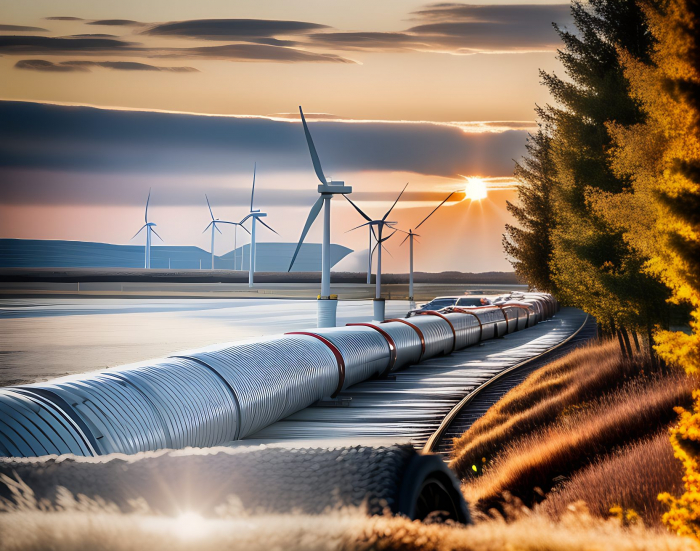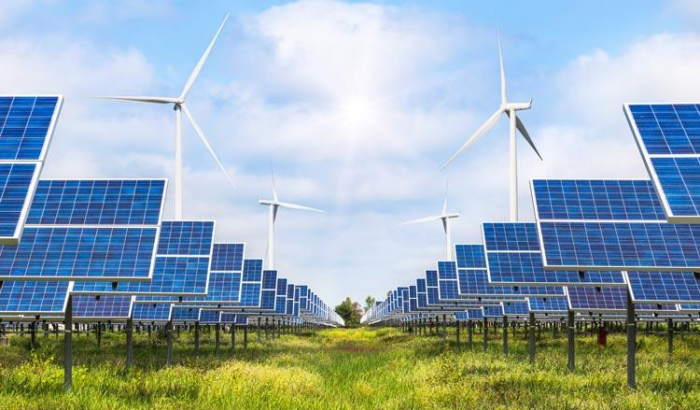Global climate change is getting worse, and the main driver of climate change is the greenhouse effect. The role of human activities in today’s climate change is mainly driven by use of fossil fuels, therefore the key question on the agenda is the development of natural climate solutions to reduce greenhouse gas emissions (GHG) and the use of renewable energy sources (RES). Nonetheless, it should be noted that in spite of current global warming limitations to no more than 2°C by 2100, conflict between the objectives of advanced economies and growth targets of developing countries potentially hinders emission reduction. Similarly, the energy transition possibly generates new competition for critical raw materials, as well as a well-known trilemma between necessity, security and sustainability.
Within this context, a comparative analysis between the strategies adopted in the so-called “Western countries” – namely the United States (US) and the European Union (EU) – and Azerbaijan appears to be particularly interesting. First of all, in the 21st century, the US and the EU have been the birthplace of the Green New Deal movement (Council on Foreign Relations 2021), in which different political and economic souls coexisted with the aim of bringing decarbonization, new job opportunities and social justice. In parallel, in 2019 the European Union proposed the concept of climate neutrality at the continental level European Union. “Five facts about the EU’s goal of climate neutrality”. Accessed 2 February 2023. https:/www.consilium.europa.eu/en/5-facts-eu-climate-neutrality">(Council of the European Union n.d.). This implies the attainment of the net-zero balance between carbon emissions and absorption by 2050. Nonetheless, difficulties arose because of the needs of guaranteeing both growth and employment. Generally, this concept is known as “just transition”, which is applied to different areas and is implemented through concrete actions including social support, diversification and industrial innovation.
Adaptation and Mitigation in the US and EU
The US and the EU have adopted two different stances with regards to climate change, and therefore the adaptation and mitigation strategies employed to tackle global warming do not overlap. As far as mitigation strategies are concerned, in 2022 the Inflation Reduction Act (IRA) has been adopted in the US to strengthen clean energy infrastructure, thus encouraging energy transition as a driver of macroeconomic recovery and relaunch (The White House 2023). At the same time, within the energy sector specific objectives have been set, namely the need of lower energy costs, an increase of climate investments to reduce carbon emissions by 40% by 2030, the creation of jobs in the manufacturing sector and the support of disadvantaged communities. For this reason, IRA facilitates the deployment of renewable technologies, incentivizes manufacturing and it especially aims at minimizing the dependence of the United States on China.
Conversely, the EU mitigation strategies are mainly centered upon the REPowerEU (European Commission 2022a) and the Net-Zero Industry Act (European Commission n.d.), which pursue a sustainable energy policy along three directives. These include the development and the implementation of clean energy alternatives (namely renewables and nuclear); the management of demand and the saving of energy while supporting equal affordability and access; and the phase out of carbon energy through diversification of energy sources in light of ongoing geopolitical tensions, especially with the Russian Federation after the war in Ukraine. In this sense, Azerbaijan appears to be particularly interesting for Europe. Eventually, it should be noted that aggressive and ambitious plans of the European Commission concerning energy & climate objectives have generated opposition by member States, which challenge the forced recourse to electrification.
Shifting to adaptation, in Europe adaptation policies have been developed across all levels of government, with some planning integrated into coastal and water management, environmental protection and land planning, and into disaster risk management. Likewise, in North America, governments are engaging in incremental adaptation assessment and planning, particularly at the municipal level. Some proactive adaptation is occurring to protect longer-term investments in energy and public infrastructure.

The competition for critical raw materials
A further element to be considered when discussing energy transition is the competition for critical raw materials (CRM), which are essential to develop clean energy technologies. Remarkably, the availability of CRM determines a new hierarchy of geopolitical relevance and quest and requires the consideration of some elements to ensure the security of nations. These are sustainability, independence, affordability and accessibility. In this sense, the dependence from China, where the greatest amount of these materials is located, is accrued by ongoing tensions and revisionists moods, shedding light on the fact that supply chains cannot be dominated by one single country.
The adoption of the Critical Raw Materials Act (European Commission 2023) in the EU had the effect of expanding cooperation between member States in mineral extraction, processing, recycling and common stockpiling. Similarly, an element of convergence with the United States concerns the pursuit of aggressive de-risking CRM policies aimed at reducing supply-chain dependence from China through negotiation and legislation, and the attempt to find alternative sources from other nations.
Climate and energy policies in Azerbaijan
On its side, the Republic of Azerbaijan signed the Paris Agreement on climate change in 1996 and committed to decrease the level of GHG emissions by 35% in 2030 compared to the base year (1990). Moreover, in November 2021, during the 26th UN Climate Change Conference of the Parties (COP26) held in Glasgow, Azerbaijan renewed its voluntary obligations by reducing the amount of GHG emissions by 40% by 2050 and declaring the liberated territories a “net zero emission” zone (Ministry of Energy of the Republic of Azerbaijan 2023a). Garabagh, East Zangezur and the Nakhchivan Autonomous Republic have been declared “green energy zone” as these regions have a significant potential to use various resources of renewable energy (hydropower, solar power, wind power, geothermal power).
In recent years, accelerating the use of renewable energy became a key element of Azerbaijan’s energy policy. The technical potential of Azerbaijan’s onshore renewable energy sources is 135 GW and offshore is 157 GW (Ministry of Energy of the Republic of Azerbaijan 2023b). The “Law on the Use of Renewable Energy Sources in the Production of Electricity” dated May 31, 2021, defined the field of using renewable energy sources in the production of electricity, the field of activity that includes the production, storage, transmission, supply and consumption of electricity from renewable energy sources.
The Azerbaijani government targets to increase the share of the installed capacity of renewable energy to 30% in the country’s overall energy balance by 2030. According to Minister of Energy Parviz Shahbazov; “By 2027, as a result of the integration of 1870 MW of green energy into the energy system, the share of renewable energy is expected to reach 33% in electricity investment and from the current 7% to 25% in electricity generation. This means that by 2030, the goal of 30% will be overfulfilled” (Ibadli 2023). All these measures support Azerbaijan’s sustainable electricity transition, which will decrease the use of natural gas to make electricity, as well as support the green economy. By doing this, the country will diversify energy exports to global energy markets and support energy security of partners.
In July 2022, the EU and Azerbaijan signed a new Memorandum of Understanding on a Strategic Partnership in the Field of Energy, which supports further cooperation in the field of energy efficiency and renewable energy sources. As noted by Commission President Ursula von der Leyen: “Today, with this new Memorandum of Understanding, we are opening a new chapter in our energy cooperation with Azerbaijan, a key partner in our efforts to move away from Russian fossil fuels” (European Commission 2022b).
We are also laying the foundations of a long-term partnership on energy efficiency and clean energy, as we both pursue the objectives of the Paris Agreement”. Towards this end, Azerbaijan, Georgia, Hungary, and Romania signed an agreement to build an underwater electric cable under the Black Sea. The cable under the Black Sea will connect the South Caucasus with South-Eastern Europe, involving the electricity systems of these countries and continental Europe. This project will serve as the “Green Energy Corridor”, which could become a new power source for the EU as Europe seeks to diversify its energy supplies. The project will also support the energy security of Moldova and Ukraine, whose energy security is compromised by Russia’s supply cuts and the bombing of critical infrastructure.

Azerbaijan-UAE cooperation
Moreover, Azerbaijan established a successful energy partnership with the UAE’s global renewables company Masdar, ADNOC, Saudi-listed ACWA Power, Japanese TEPSCO, bp, and China Gezhouba Group Overseas Investment to implement renewable energy projects in the country. It is worth noting that on October 26, 2023 the country opened the 230 MW Garadagh Solar PV Plant built by Masdar. The Garadagh Solar PV Plant is the largest solar power plant in the Caspian region and the CIS. The plant was built at the expense of foreign investment worth $262 million. Also, Masdar has signed agreements for solar and onshore wind projects with a total capacity of 1GW, as well as developing integrated offshore wind and green hydrogen projects and onshore wind and solar projects with a total combined capacity of 4 GW. Saudi-listed ACWA Power agreed to develop 500 MW renewable energy projects in Azerbaijan’s Nakhchivan Autonomous Republic with Masdar and the State Oil Company of Azerbaijan Republic (SOCAR).
The recent signed MOU between the Ministry of Investment of the United Arab Emirates and the Ministry of Energy of the Republic of Azerbaijan deepened even more energy cooperation as the strategic cooperation document covers cooperation and investment opportunities in new areas such as the rooftop solar projects, green hydrogen, green ammonia, synthetic methane, sustainable aviation fuel production and export of green energy, along with 2 GW solar and 2 GW wind onshore projects, 6 GW offshore wind energy (Ministry of Energy of the Republic of Azerbaijan 2024). To be brief, all the abovementioned green energy projects will accelerate Azerbaijan’s progress towards the goal of green transition.
Conclusion: Azerbaijan ready to host COP29
In the end, the Presidential Order to declare 2024 as the “Green World Solidarity Year” in Azerbaijan is an important measure to demonstrate Azerbaijan’s commitment to environmental protection and climate action. Azerbaijan’s role as a reliable energy partner and responsible member of the international community in the fight against global warming was recognized by many countries. Given that the country won the backing from other Eastern European countries to host the 29th Conference of Parties (COP29) to the UN Framework Convention on Climate Change. The UN climate summit will be an important platform to support international cooperation to act on climate change and implement the Paris Agreement (Hajiyev 2024). In addition, Azerbaijan may put important topics such as environmental threats of war and landmine threats on the COP29 agenda as the country suffers from environmental degradation and landmine contamination following the former Karabakh war.
AzVision.az
More about:
















































